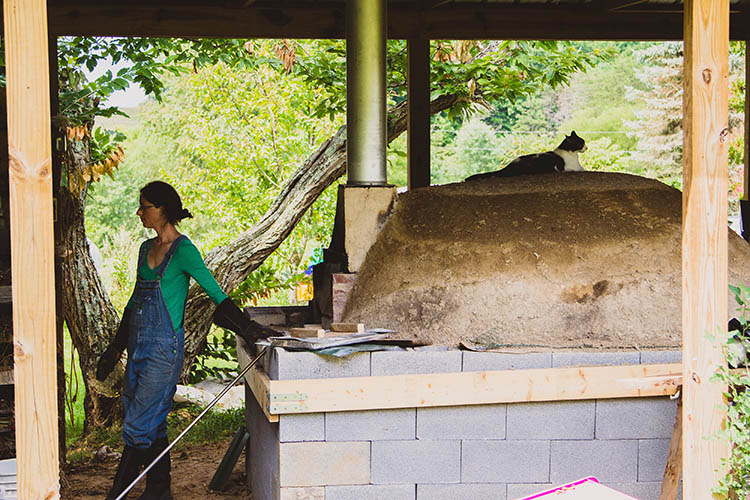Working vegetable farm finds new hands
In his search for the right piece of farmland, Ben Stowe spent a considerable amount of time “walking the grid.”
He’d look up the soil maps for a prospective plot, taking into consideration that some of them hadn’t been updated in a half-century, and then he’d put his boots on the ground. One property looked nice and flat on its surface — perfect for harvesting a few acres of vegetables — but the map said its soils were “stony alluvial” and could be plagued with rocks.
“So I went out there with a digging fork, paced a grid and hit a lot of rocks. I didn’t think I wanted to farm that,” said Stowe, who can only imagine what the process might look like if he was looking to buy, rather than lease, the land he farms.
“You don’t want to be signing a lease on something that isn’t going to grow well for you,” he said.
Stowe spent months scouring Northern Virginia acreage like this with a landowner who was interested in buying property for a second home and leasing much of it to a small farmer.
It was a unique opportunity, and Stowe was close to settling on a lease with him — until he was lured away by a better offer. A couple that understood firsthand what he would need in a piece of land — because they’d been farming it themselves for the past decade — was looking for a farmer.
The partnership
Michael and Kathryn Bertoni thought the five-acre plot in Nelson County was “about as pretty a spot as you can hope to find” when they bought it in 2003. They’d just finished an eight-month internship at Waterpenny Farm, an ecological growing haven in Rappahannock County that has spawned several likeminded farms in the region, and they were eager to set out on their own.
But, after a decade of selling produce and eggs from their Appalachia Star Farm, the Bertonis, now in their late 30s with two young children, were tired, mostly of all the driving this brand of farming entailed.
“It was just a hectic lifestyle, and we decided to let it go for a little while,” said Michael Bertoni.
He said leasing the property as an entire farm made better economic sense for their family than just renting out the house, which wouldn’t have taken into account the property’s full value.
The Bertonis also wanted the land to remain in sustainable agriculture, so they put it up for lease on the Virginia Farm Link Database that’s run by the state Department of Agriculture and Consumer Services.
If you want to be near a metro area, in areas where land is relatively unaffordable for people like us, leasing is a great option.
Stowe, who had also just finished an internship at Waterpenny Farm, began perusing the database for landowners who used terms like “good stewardship” in their postings. After working at small farms in Wisconsin, California and Oregon, Stowe said interning at Waterpenny showed him he could have a successful farm business by leasing land.
“If you want to be near a metro area, in areas where land is relatively unaffordable for people like us, leasing is a great option,” he said.
He didn’t realize when he first replied to the Bertonis’ posting that they also were Waterpenny alumni — or that he’d visited their farm as an intern in 2011. Since then, Stowe had met his partner, Heather Coiner, at a music festival. The two had decided to get some land together where he could grow vegetables and she could bake bread. The idea of stepping into a property with practically everything they’d need — and into the former farm’s slots at farmers markets — was more than appealing.
‘They want us to succeed’

Named for a stream that runs alongside the five-acre property, Stowe and Coiner’s Little Hat Creek Farm is now in its first full year selling produce and “old-time bread” at markets in the Charlottesville area and through an 18-member CSA.
Coiner had worked on a farm before and was baking and selling bread through a CSA in Toronto when she met Stowe.
They signed a two-year lease on the property, which also includes the house they live in and most of the equipment they need to run a small farm. Along with a greenhouse, market tent and bins for picking produce, the farm already featured several perennial berry bushes and asparagus that “really helped us in our first year,” Stowe said from a shaded picnic bench near the house, a carton of perfectly ripe blackberries leftover from a recent market sitting on the table.
“Our situation is unique, because it was a working vegetable farm already,” he said. “They’ve done what we’re doing, so they want us to succeed. We’re lucky in that way.”
Even though they were working with likeminded landowners, Stowe and Coiner went to great lengths to craft their first lease agreement for the property.
They had learned from Waterpenny the importance of a solid lease, and Stowe had taken some notes while looking for the right property with other landowners. Sample leases they’d found online helped them consider factors they might not have otherwise, like maintenance costs.
Our situation is unique, because it was a working vegetable farm already. They’ve done what we’re doing, so they want us to succeed. We’re lucky in that way.
Their lease originally said the farmers would fix or maintain anything that cost less than $100 and call the owners, who now live in Crozet, if it cost more. But they soon realized that the cost of “maintaining” unfarmed portions of land with regular mowing was adding up fast.
“We sort of left that out, so we had to negotiate that with them after the fact,” said Coiner, who ended up striking a compromise with the owners to split lawn care costs.
Making additions
Stowe and Coiner said it was important to craft a lease that left their options open for additions in the future, like animals, while still describing the type of farming they planned to do in the present.
“I feel like the onus is kind of on the farmer to try to imagine all the things that they might want to do on the land,” said Coiner.

If they hadn’t put it in their lease, for example, it would have been difficult for the Bertonis to imagine the wood-fired oven that now fills a portion of the pole barn next to the house.
Stowe and Coiner built the oven with a base of recycled glass bottles from nearby wineries, using sawdust from a local woodshop to form the seven inches of clay. After beginning construction in the winter, Coiner began using the oven this summer to bake up to 32 of her naturally leavened loaves at a time.
But, before they broke ground on the massive project, the farmers made sure the landowners approved — and that the oven was addressed in their lease.
“We were planning to invest in this major construction project that was going to alter one of the structures,” Coiner said. “How do they feel about that? And, if we decide to leave the property, do they compensate us for its value or do we have to pay for it to be removed?”
After discussing these questions, the Bertonis agreed in the lease to purchase any value-adding modifications to the property, like the oven, should Coiner and Stowe move elsewhere.
The Bertonis liked the idea of the oven, not to mention the loaves it produces, but “I think they were still surprised at how big it was,” Stowe said with a chuckle. “I think Michael’s comment was, ‘That is massive.’”
While there are sure to me more surprises, as Stowe and Coiner continue to build their farm business on the land they lease from the Bertonis, the solid groundwork that they have all built and the common language that they speak as farmers will be invaluable.
This story is part of “Finding a Place to Grow“, a publication produced by The Piedmont Environmental Council. The stories were written by Whitney Pipkin, a freelance journalist from Alexandria, VA who covers food, farms, and the environment. Her work appears in the Washington Post, Virginia Living and the Chesapeake Bay Journal, among others, and she writes at thinkabouteat.com. Photos were taken by Jami McDowell.
The publication was made possible by a grant from The Beirne Carter Foundation.
